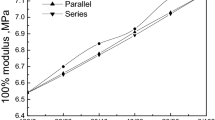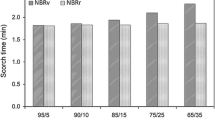Abstract
Rubbers are used in many applications in industries such as chemistry, automotive, agriculture, and aviation. However, different types of rubbers should be used to meet the end-user expectations in all these areas of use. In recent years, the use of the blending method has obtained both superior properties and low-cost rubbers with the synergistic effect of two different rubbers. Ethylene acrylic rubber (AEM) is resistant to heat, chemicals, and ozone, but it is not well resistant to low aniline oil and polar solvents. In addition, AEMs are much more expensive than most standard elastomers. In this study, the upside-down method was applied to preparing the series of AEM and Ethylene propylene diene monomer (EPDM) rubber blends in a Banbury-type internal mixer. Rubber blends were a mixture of AEM and EPDM rubber in 90/10, 20/80, 30/70, and 60/40 phr rubber ratio variation. In addition, each of the blends was tested to determine rheological and mechanical properties such as tensile strength, elongation at break, hardness and compression set as well as thermal and oil (IRM 901 and IRM 903) aging effects. The 10% addition of EPDM rubber causes an increment in the compression set, the tensile strength, and elongation at break. It was observed that the tensile strength values of A100 and A90E10 samples were larger than 8 MPa and the hardness value did not change after aging in IRM 901 oil. A100 and A90E10 samples show satisfying results to the requirements SAEJ200M3EE708 standard.






Similar content being viewed by others
References
Gao T, Na B, Choi H, Chung K (2018) Effect of zinc oxide induced metal-ligand crosslink on the mechanical properties in the ethylene acrylic elastomer (AEM). Mater Lett 214:154–157. https://doi.org/10.1016/j.matlet.2017.11.125
Kammerer K (2013) High viscosity AEM rubbers for increased demands on seals in the automotive industry. Int Polym Sci Technol 40:1–8. https://doi.org/10.1177/0307174X1304000801
Gao T, Xie R, Chung K (2018) Microstructure and dynamic mechanical properties of magnetorheological elastomer based on ethylene/acrylic elastomer prepared using different manufacturing methods. Micro Nano Lett 13:1026–1030. https://doi.org/10.1049/mnl.2017.0372
Jovanović S, Samaržija-Jovanović S, Marković G, Jovanović V, Adamović T, Marinović-Cincović M (2018) Ternary NR/BR/SBR rubber blend nanocomposites. J Thermoplast Compos Mater 31:265–287. https://doi.org/10.1177/0892705717697778
Guo R, Talma AG, Datta RN, Dierkes WK, Noordermeer JWM (2009) A phase blending study on rubber blends based on the solubility preference of curatives. Macromol Mater Eng 294:635–642. https://doi.org/10.1002/mame.200900098
Dong H, Luo Y, Zhong B, Bai J, Jia D (2020) Effects of vulcanization accelerator functionalized graphene on the co-vulcanization kinetics and mechanical strength of NR/SBR blends. Polym Test 81:106169. https://doi.org/10.1016/j.polymertesting.2019.106169
Paran SMR, Naderi G, Javadi F, Shemshadi R, Saeb MR (2020) Experimental and theoretical analyses on mechanical properties and stiffness of hybrid graphene/graphene oxide reinforced EPDM/NBR nanocomposites. Mater Today Commun 22:100763. https://doi.org/10.1016/j.mtcomm.2019.100763
Akçakale N, Bülbül Ş (2017) The effect of mica powder and wollastonite fillings on the mechanical properties of NR/SBR type elastomer compounds. J Rubber Res 20:157–167. https://doi.org/10.1007/BF03449149
Botros SH (2002) Preparation and characteristics of NR/EPDM rubber blends. Polym Plast Technol Eng 41:341–359. https://doi.org/10.1081/PPT-120002572
Prasertsri S, Kurakanok K, Sukkapan N (2016) Physico-mechanical properties and automotive fuel resistance of EPDM/ENR blends containing hybrid fillers. J Polym Res 23:228. https://doi.org/10.1007/s10965-016-1123-1
Maity M, Das CK (2001) Specıalty polyblend systems of polyurethane rubber and ethylene acrylıc rubber (peroxıde cure). Polym Plast Technol Eng 40:39–51. https://doi.org/10.1081/PPT-100000118
Şentürk Ünal G, Ersoy Meriçboyu A (2018) Development of an intermediate layer for multilayer hoses used in turbo lines of motor vehicles: Research Article. J. Appl. Polym. Sci. 135:46525. https://doi.org/10.1002/app.46525
Mathew G, Rhee JM, Lee Y-S, Park DH, Nah C (2008) Cure kinetics of ethylene acrylate rubber/clay nanocomposites. J Ind Eng Chem 14:60–65. https://doi.org/10.1016/j.jiec.2007.07.001
Oriani SR (2016) Reinforcement of ethylene-acrylic elastomer with a dispersion of grafted PA6 droplets. J Appl Polym Sci. https://doi.org/10.1002/app.43995
Reffai Syed Ismail SM, Chatterjee T, Naskar K (2015) Development of novel polar thermoplastic vulcanizates based on ethylene acrylic elastomer and polyamide 12 with special reference to heat and oil aging. J Appl Polym Sci. https://doi.org/10.1002/app.42655
Son W-J, Bae D-C, Park D-J, Kim W (2013) Peel strength and fatigue resistance of AEM rubber–polyester fabric composites (II); application of hydrated silica, resorcinol, and hexamethoxymethylmelamine (HRH) system and double dip system. Compos Interfaces 20:73–91. https://doi.org/10.1080/15685543.2013.763023
Son W-J, Kim W (2013) Peel strength and fatigue resistance of AEM rubber–polyester fabric composites (I): application of isocyanate adhesive solution. Compos Interfaces 20:57–71. https://doi.org/10.1080/15685543.2013.762896
Sahoo BP, Naskar K, Tripathy DK (2012) Conductive carbon black-filled ethylene acrylic elastomer vulcanizates: physico-mechanical, thermal, and electrical properties. J Mater Sci 47:2421–2433. https://doi.org/10.1007/s10853-011-6065-8
de Haro Moreno PH, Visconte LLY, da Silva ALN, do Couto Tavares E, Pacheco EBAV, Lopes TC (2017) Breakage of sulfur crosslinks in styrene-butadiene rubber by zinc(II) dithiocarbimate derivative. Colloid Polym Sci 295:2041–2050. https://doi.org/10.1007/s00396-017-4182-x
Zheng L, Jerrams S, Xu Z, Zhang L, Liu L, Wen S (2020) Enhanced gas barrier properties of graphene oxide/rubber composites with strong interfaces constructed by graphene oxide and sulfur. Chem Eng J 383:123100. https://doi.org/10.1016/j.cej.2019.123100
Author information
Authors and Affiliations
Corresponding author
Ethics declarations
Conflict of interest
The authors declare that they have no known competing financial interests or personal relationships that could have appeared to influence the work reported in this paper.
Additional information
Publisher's Note
Springer Nature remains neutral with regard to jurisdictional claims in published maps and institutional affiliations.
Rights and permissions
About this article
Cite this article
Öztürk, S., Erbek Cömez, E. & Hoşgün, H.L. The rheological, mechanical and aging properties of AEM/EPDM rubber blends. J Rubber Res 24, 61–67 (2021). https://doi.org/10.1007/s42464-020-00073-5
Received:
Accepted:
Published:
Issue Date:
DOI: https://doi.org/10.1007/s42464-020-00073-5




